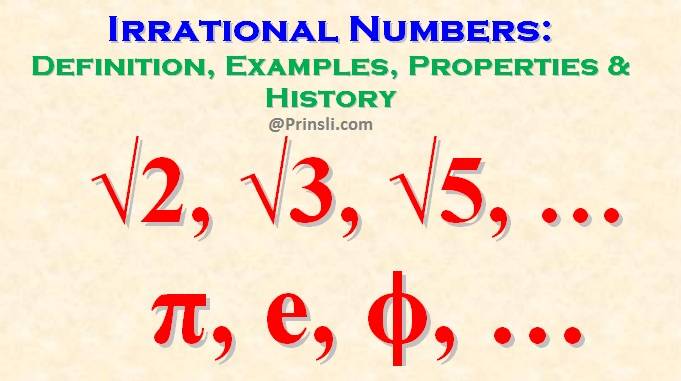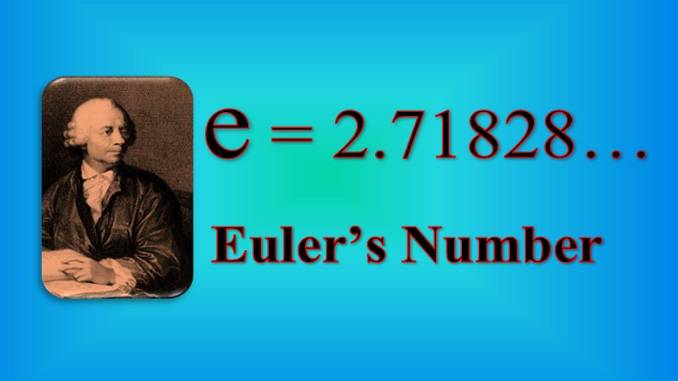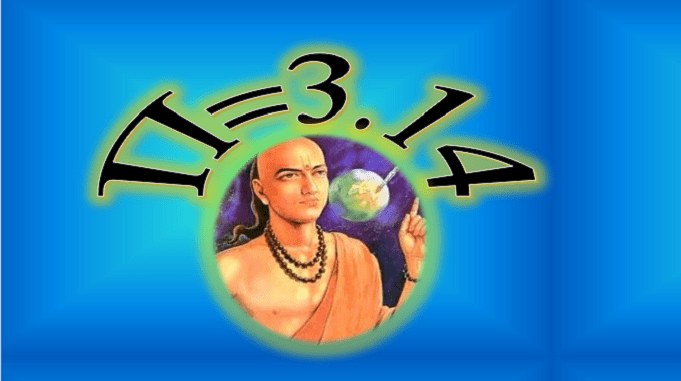
Irrational Numbers
Irrational Numbers Definition:
What is an irrational number?
- Irrational numbers are real numbers that are not rational.
- An irrational number is a number that cannot be expressed as a quotient (ratio or fraction) of two integers, that is, it cannot be written in the form p/q, where p and q are integers and q≠0.
- Irrational numbers are roots that cannot be simplified to rational numbers. For example,
- If a number is not a perfect square, its square root is an irrational number.
- If a number is not a perfect cube, its cube root is an irrational number.
- If a number is not a perfect nth power, its principal nth root is an irrational number.
- In decimal form, irrational numbers are those decimals that do not repeat or terminate. That is, an irrational number is one whose decimal expansion is non-terminating non-recurring.
Sometimes, irrational numbers are denoted by S or Q’ (Complement of the set of rational number Q).
Irrational Numbers Examples:
- The number
is an irrational number because 30 is not a perfect cube.
- The number
is an irrational number because 50 is not a perfect square.
- Similarly, the numbers:
, etc. are irrational numbers.
- The numbers: 1.010010001…, 0.12122122212222…, 2.3010010001…, 0.31311…, 4.1010010001…, etc. are irrational numbers because these numbers are in the decimal form and the decimals do not repeat and do not terminate. (Note – Some of these numbers have a pattern but it is not the special type of pattern that rational numbers have.)
- The famous irrational numbers are π (Pi), Euler’s number e, and the Golden ratio.
Properties of Irrational Number:
- If R is rational and S is irrational, then R+S and R-S are irrational numbers.
- If R is rational and S is irrational, then R×S and R/S are irrational numbers if R≠0.
- The addition of two irrational numbers may be rational.
- The product of two irrational numbers may be rational.
- For example, the product of two irrational numbers:
and
; is 4 which is a rational number,
(rational number)
(irrational number)
- LCM of two irrational numbers may or may not exist.
- Every irrational number is represented by a unique point on the number line.
- All rational and irrational numbers are real numbers.
- All rational, irrational and real numbers are complex numbers.
- There are infinitely many rational and irrational numbers between two rational or irrational numbers.
Some Solved Examples of Irrational Numbers:
Example 1: Prove that (where p is a prime, or p is not a perfect square) is irrational.
Proof: We prove this by contradiction.
Assume that, for a contradiction, is rational.
Then, we can find two integers m and n (n≠0), such that:
Assume that m and n have a common factor other than 1. Then, divide m and n by this common factor to get
…… (1)
where, a and b are coprime, that is, a and b have not any common factor other than 1.
Then, (1) implies that,
.
This implies that, is divisible by p, that is, p divides
.
According to the Theorem states that, “Let be a prime number. If
divides
, then
divides
, where
is a positive integer.” From this theorem we get,
divides
also, that is,
is also divisible by
.
So, we can write,
for some integer
Substitute in
, then we get
This means that, divides
, and so,
divides
.
Hence, finally we get, divides a, and
divides b, that is,
divides both a and b.
It means, a and b have at least as a common factor.
But this contradicts the fact that a and b have no common factors other than 1. So, our assumption, is rational, is wrong.
Hence, it is proved that (where p is a prime, or p is not a perfect square) is irrational.
Example 2: Prove that is irrational.
Proof: We prove this by contradiction.
Assume that, for a contradiction, is rational.
Then, we can find two integers m and n (n≠0), such that:
Assume that m and n have a common factor other than 1. Then, divide m and n by this common factor to get
…… (1)
where, a and b are coprime, that is, a and b have not any common factor other than 1.
Then, (1) implies that,
.
This implies that, is divisible by 2, that is, 2 divides
.
According to the Theorem states that, “Let be a prime number. If
divides
, then
divides
, where
is a positive integer.” From this theorem we get, 2 divides
also, that is,
is also divisible by 2.
So, we can write,
for some integer
Substitute in
, then we get
This means that 2 divides , and so, 2 divides
.
Hence, finally, we get, 2 divides a, and 2 divides b, that is, 2 divides both a and b.
It means that a and b have at least 2 as a common factor.
But this contradicts the fact that a and b have no common factors other than 1. So, our assumption, is rational, is wrong.
Hence, it is proved that is irrational.
Example 3: Prove that is irrational.
Proof: We prove this by contradiction.
Assume that, for a contradiction, is rational.
Then, we can find two integers m and n (n≠0), such that:
Assume that m and n have a common factor other than 1. Then, divide m and n by this common factor to get
…… (1)
where, a and b are coprime, that is, a and b have not any common factor other than 1.
Then, (1) implies that,
.
This implies that, is divisible by 3, that is, 3 divides
.
According to the Theorem states that, “Let be a prime number. If
divides
, then
divides
, where
is a positive integer.” From this theorem we get, 3 divides
also, that is,
is also divisible by 3.
So, we can write,
for some integer
Substitute in
, then we get
This means that 3 divides , and so, 3 divides
.
Hence, finally, we get, 3 divides a, and 3 divides b, that is, 3 divides both a and b.
It means that a and b have at least 3 as a common factor.
But this contradicts the fact that a and b have no common factors other than 1. So, our assumption, is rational, is wrong.
Hence, it is proved that is irrational.
Example 4: Prove that is irrational.
Proof: We prove this by contradiction.
Assume that, for a contradiction, is rational.
Then, we can find two integers m and n (n≠0), such that:
Assume that m and n have a common factor other than 1. Then, divide m and n by this common factor to get
…… (1)
where, a and b are coprime, that is, a and b have not any common factor other than 1.
Then, (1) implies that,
.
This implies that, is divisible by 5, that is, 5 divides
.
According to the Theorem states that, “Let be a prime number. If
divides
, then
divides
, where
is a positive integer.” From this theorem we get, 5 divides
also, that is,
is also divisible by 5.
So, we can write,
for some integer
Substitute in
, then we get
This means that 5 divides , and so, 5 divides
.
Hence, finally, we get, 5 divides a, and 3 divides b, that is, 5 divides both a and b.
It means that a and b have at least 5 as a common factor.
But this contradicts the fact that a and b have no common factors other than 1. So, our assumption, is rational, is wrong.
Hence, it is proved that is irrational.
Example 5: Show that the irrational-looking expression: ; is actually a rational number.
Proof: Observe that,
Because 1 is a rational number, and,
,
hence this number is actually a rational number.
History of Irrational Number:
♦ During the Vedic period in India, geometrical and mathematical problems involving irrational numbers, such as square roots, were addressed very early. Around 800 BC or earlier, such calculations are mentioned in the Samhitas, Brahmanas, and Shulba Sutras.
♦ Indian mathematicians implicitly accepted the “Concept of Irrationality” since the 7th century, when Manava (Author of the Hindu geometric text of Sulba Sutras) believed that the square roots of certain numbers, like 2 and 61, could not be precisely calculated. However, according to historian Carl Benjamin Boyer, “such claims are not well evidenced and are unlikely to be true.”
♦ Additionally, it is believed that Aryabhata (5th century AD) used the word āsanna (approaching) to indicate that the value of π is not only an approximation but also incommensurable (or irrational) when he calculated it to 5 significant figures.
♦ Mathematicians like Brahmagupta (in 628 AD) and Bhāskara I (in 629 AD)as well as others who came after them contributed to this field. Some of these formulas were evaluated and critiqued by Bhāskara II in the 12th century, identifying their limitations.
♦ Madhava of Sangamagrama and the Kerala School of Astronomy & Mathematics discovered the infinite series for several irrational numbers such as π and certain irrational values of trigonometric functions during the 14th and 16th centuries. In the Yuktibhāṣā, Jyeṣṭhadeva provided proofs for these infinite series.
♦ Generally, a Pythagoreans (possibly Hippasus of Metapontum) is credited to provide the first proof of the existence of irrational numbers. It is believed that irrational numbers were first discovered by the Pythagoreans in Greece around 400 BC, followers of the famous mathematician and philosopher Pythagoras.
- Tags: pi is rational or irrational, prove that root 2 is irrational, prove that root 3 is irrational, prove that root 5 is irrational, prove that root p is irrational, rational and irrational numbers, the product of two irrational numbers is
Copyrighted Material © 2019 - 2024 Prinsli.com - All rights reserved
All content on this website is copyrighted. It is prohibited to copy, publish or distribute the content and images of this website through any website, book, newspaper, software, videos, YouTube Channel or any other medium without written permission. You are not authorized to alter, obscure or remove any proprietary information, copyright or logo from this Website in any way. If any of these rules are violated, it will be strongly protested and legal action will be taken.




Be the first to comment